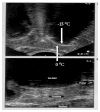Mechanisms of cryoablation: clinical consequences on malignant tumors
- PMID: 24239684
- PMCID: PMC3976170
- DOI: 10.1016/j.cryobiol.2013.11.001
Mechanisms of cryoablation: clinical consequences on malignant tumors
Abstract
While the destructive actions of a cryoablative freeze cycle are long recognized, more recent evidence has revealed a complex set of molecular responses that provides a path for optimization. The importance of optimization relates to the observation that the cryosurgical treatment of tumors yields success only equivalent to alternative therapies. This is also true of all existing therapies of cancer, which while applied with curative intent; provide only disease suppression for periods ranging from months to years. Recent research has led to an important new understanding of the nature of cancer, which has implications for primary therapies, including cryosurgical treatment. We now recognize that a cancer is a highly organized tissue dependent on other supporting cells for its establishment, growth and invasion. Further, cancer stem cells are now recognized as an origin of disease and prove resistant to many treatment modalities. Growth is dependent on endothelial cells essential to blood vessel formation, fibroblasts production of growth factors, and protective functions of cells of the immune system. This review discusses the biology of cancer, which has profound implications for the diverse therapies of the disease, including cryosurgery. We also describe the cryosurgical treatment of diverse cancers, citing results, types of adjunctive therapy intended to improve clinical outcomes, and comment briefly on other energy-based ablative therapies. With an expanded view of tumor complexity we identify those elements key to effective cryoablation and strategies designed to optimize cancer cell mortality with a consideration of the now recognized hallmarks of cancer.
Keywords: Cryoablation; Cryosensitizers; Cryosurgery; Cryotherapy; Prostate cancer.
Copyright © 2013 Elsevier Inc. All rights reserved.
Figures


References
-
- Abern MR, Tsivian M, Polascik TJ. Focal therapy of prostate cancer: Evidence-based analysis for modern selection criteria. Curr Urol Rep. 2012;13:160–9. - PubMed
-
- Akimov AB, Seregin VE, Rusanov KV, Tyurina EG, Glushko TA, Nevzorov VP, et al. Nd: Yag interstitial laser thermotherapy in the treatment of breast cancer. Lasers Surg Med. 1998;22:257–67. - PubMed
-
- Atwell TD, Carter RE, Schmit GD, Carr CM, Boorjian SA, Curry TB, et al. Complications following 573 percutaneous renal radiofrequency and cryoablation procedures. J Vasc Interv Radiol. 2012;23:48–54. - PubMed
-
- Babaian RJ, Donnelly B, Bahn D, Baust JG, Dineen M, Ellis D, et al. Best practice statement on cryosurgery for the treatment of localized prostate cancer. J Urol. 2008;180:1993–2004. - PubMed
Publication types
MeSH terms
Grants and funding
LinkOut - more resources
Full Text Sources
Other Literature Sources
Medical

